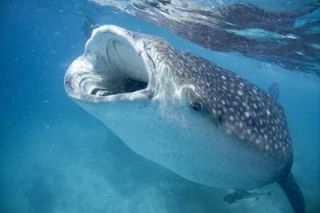
Family Name: Rhinocodontidae
Scientific Name: Rhicodontypus
IUCN Status: Endangered
Weight: 20.6 tons (18.7 metric tons)
Length: grows up to 40 feet
(12metres) long
Habitat: found in warmer areas and
found in tropical areas eg.Indian,
Pacific and Atlantic oceans
Also found in cooler areas eg.off the
coast of New York
Lifespan: can live upto 100 to 150
years
Interesting Facts
- They are the biggest fish
- They are not whales but are a type of sharks
- Slow-moving and are filter feeders
- They have 3000 tiny teeth
- They can open their mouth about five feet long

- They have a flattened blunt snout ,short barbels
- Backs and sides – gray to brown with white spots and pale yellow strips
- Barbels – whisker like sensory organs like catfish has which protude from their nostrils
- Each whale shark has a unique pattern of spots
- They are solitary creatures
- Red sea – popular for juvenile whale sharks to hang out and eat together
- They have a long childhood
- Female whale sharks produces eggs but the youngs hatch inside of the mother instead in the water
- They give birth to live youngs
- The off springs are ready to have their own youngs at the age of 25

- They are the largest living non-
mammalian animal - They are ovoviviparous
- They are called as ovoviparous
- Ovoviviparous – animals whichlay and develop eggs inside themother’s body. The eggs are hatched inside the mother’s body.eg. sharks,snakes,fish,rays and insects
- Whale sharks have been observed “ coughing” to clear a build up of particlesfrom the filter pads
- They migrate to feed and to breed
- What they eat: Plankton is the main source of food

- They also eat shrimp,algae & other marine plant material,sardines,anchovies, mackerels,small squid & fish,tuna,albacore,krill,copepods,ch ristmas island red crab larvae,jellyfish and fish eggs.













- They wait for 14hours to fish to spawn on reefs. Then they will swoop in and eat the eggs
- They eat 21kg (46 pounds) plankton per day
- They are often refered as “Gentle Giants” and considered harmless.
Threats
- Fisheries,bycatch losses and demand for shark fins,liver,oil,skin and meat